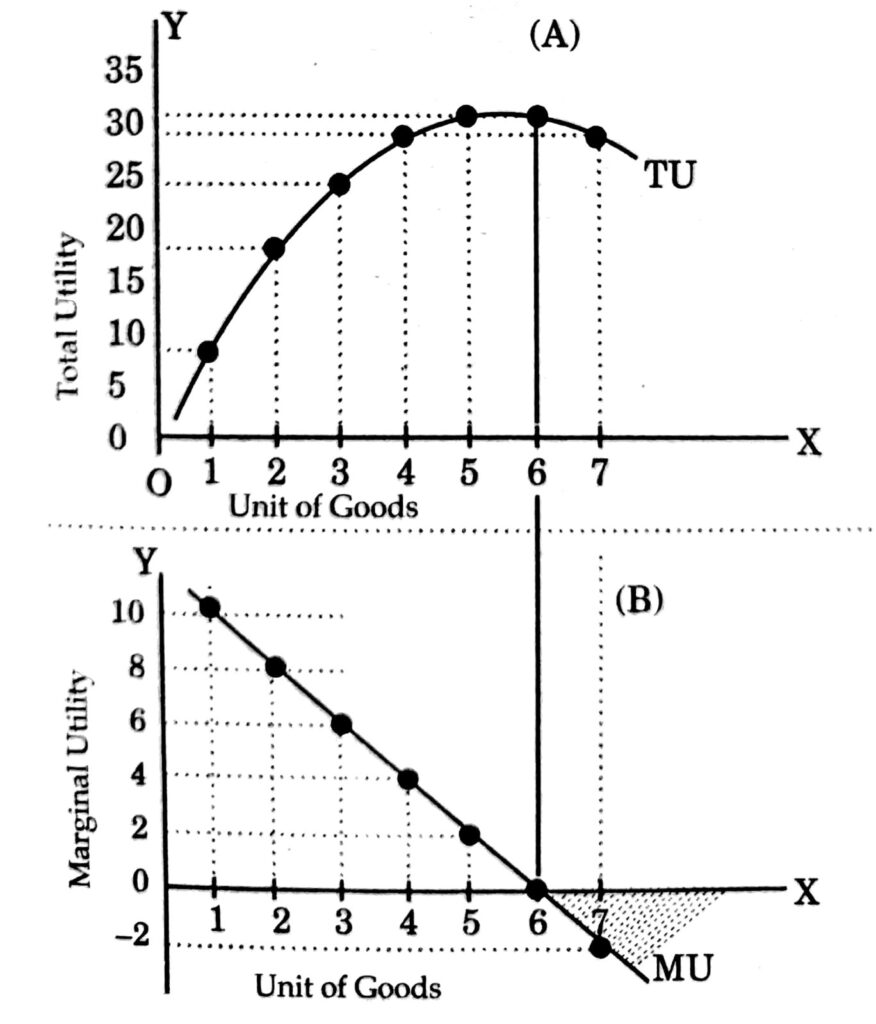| In this article, we tried to explain the law of diminishing marginal utility |
Contents
Introduction
The Law of Diminishing Marginal Utility was originally formed by German economist Hermann Heinrich Gossen in 1854. So, the law is also known as the first law of Gossen. It was systematically formulated and made popularized by Alfred Marshall in his book ‘Principle of Economics’ in 1890.
The law asserts that as a consumer eats more and more units of a commodity, marginal utility resulting from each consecutive unit goes on declining.
Following this, a stage comes where marginal utility becomes zero and the total utility becomes maximum. If the customer uses beyond this stage, marginal utility becomes negative, and total utility falls. It means that the consumer begins receiving disutility i.e., dissatisfaction instead of getting satisfaction. Since economists believe that a consumer is a rational being, s/he wants to maximize his/her satisfaction. Thus, a consumer would not like to go beyond zero marginal utility.
According to Marshall, “The additional benefit which a person derives from a given increase of his stock of a thing diminishes with every increase in the stock that he already has.”
Assumptions
The law of diminishing marginal utility is based on the following assumptions.
- The consumer should be rational
- There is the cardinal measurement of utility
- Units of a product are homogeneous
- Constant marginal utility of money
- No time gap in consumption
- Taste, habit, and performances of a consumer remain the same
- Units in consumption are suitable in size
- The mental and social condition of the consumer must be normal.
Based on the above assumptions, the law of diminishing marginal utility can be explained with help of the following schedule.
| Units of Good Consumed | Total Utility (TU) in Utils | Marginal Utility (MU) in Utils |
| 1 | 10 | 10 |
| 2 | 18 | 18-10=8 |
| 3 | 24 | 24-18=6 |
| 4 | 28 | 28-24=4 |
| 5 | 30 | 30-28=2 |
| 6 | 30 | 30-30=0 |
| 7 | 28 | 28-30=-2 |
The table shows that when a consumer consumes the first unit of a commodity, he/she obtains 10 utils of total utility. As the second unit is consumed, MU is 8 units whereas TU is increased to 18 from 10 utils. Accordingly, if the consumer consumes 3rd to 5th unit of goods over time, TU increases at decreasing rate. When the consumer consumes the sixth unit of consumption, MU is zero and TU is maximum. When the seventh unit is eaten, MU is negative by -2, and TU declines to 28 utils from 30 utils.
This law is also illustrated by the following figure.

In the above diagram, TU stands for the total utility curve and MU stands for the marginal utility curve. When the consumer consumes the first unit of commodity, s/he derives 10 utils of utility and both TU and MU are the same. When the consumer consumes the second unit of goods, TU becomes 18 utils and MU decreases to 8 utils. Here, adding MUs give is the value of total utility.
Following the sequence, when the consumer consumes the sixth unit of goods, MU decreases to zero where TU becomes maximum (30 utils). After the 6th unit consumption of goods, MU is negative and due to negative MU, total utility declines to 28 utils from 30 utils. Thus, the consumer gets maximum satisfaction when MU is zero and that point is known as the point of saturation.
From the above discussion, it can be inferred that as more and more units of a commodity are consumed, the marginal utility from each successive unit goes on diminishing.
Conclusion
This law was developed by German Economist H.H. Gossen. The law states that the additional utility or marginal utility derived from the consumption of every additional unit of a commodity goes on diminishing.
The law of diminishing marginal utility is based on the two facts. The first is that human wants are limitless but, every single want is satiable for a time being. The second is that commodities are not perfect substitutes for each other. Following these two facts, this law holds true.
Limitations/Exceptions to the Law of Diminishing Marginal Utility
The major drawbacks of this law are listed below.
- If units of a commodity consumed are not of the same size and shape, the law does not hold good.
- The law does not hold good when there is enough time gap between the consumption of two units. For instance, if we take a second apple after a long gap of time, we may feel hungry and hence satisfaction will increase instead of falling.
- The taste of consumers should not change for the law to hold good. It means that the person should consume all units of a good by the same desire and pleasure.
- The law does not apply to money as it is said that the more money a person has, the more he wants.
- A change in income of the consumer will falsify the law. If the money income of the consumer increases or decreases during the time of consumption of a particular set of goods, the marginal utility will not fall as explained above.
- The law is applied only in the case of normal commodities, but it is not valid for rare and curious commodities like diamonds, rare paintings, ancient coins, etc.